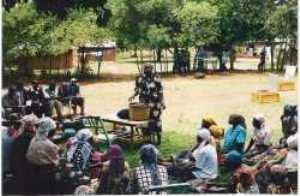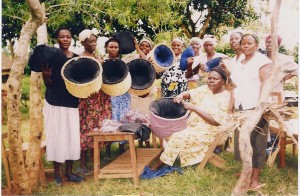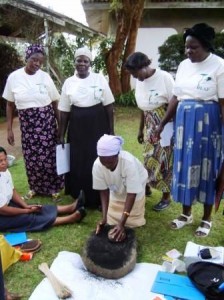 One of the greatest potentials we see in working with churches is the mid week women’s fellowships where a group of women faithfully meet together for singing, Bible reading and prayer, and have a strong sense of commitment to each other. These women are hungry for teaching and much of the holistic teaching we are developing is particularly directed to these fellowships as a channel.
One of the greatest potentials we see in working with churches is the mid week women’s fellowships where a group of women faithfully meet together for singing, Bible reading and prayer, and have a strong sense of commitment to each other. These women are hungry for teaching and much of the holistic teaching we are developing is particularly directed to these fellowships as a channel.
Many of the ideas in the CWD article can be cross linked to the teaching leaflets.
 We have been encouraging Energy Saving Stoves for a number of years. We use the liners originally developed by GTZ as being the most efficient and the easiest for rural women to use, as they just replace the traditional three stone fire. However, to our surprise when we first promoted them we found that these stoves have not spread as we would have expected. When we looked into the reason we found that the method developed of making the fired liners at production centres was not suited to getting the stoves to those who most need them. The product is difficult to market being relatively heavy, breakable, low cost and targeting the poor. To overcome this we have developed a system of moulding the liners within the community through women’s fellowships. We have found that women’s fellowships can easily make the liners if they have access to a mould, and by making a mould available to a church, many women’s fellowships at different branches can make them within their own community. By installing the liners when they are air-dried but unfired we have found a very acceptable product that is truly accessible.
We have been encouraging Energy Saving Stoves for a number of years. We use the liners originally developed by GTZ as being the most efficient and the easiest for rural women to use, as they just replace the traditional three stone fire. However, to our surprise when we first promoted them we found that these stoves have not spread as we would have expected. When we looked into the reason we found that the method developed of making the fired liners at production centres was not suited to getting the stoves to those who most need them. The product is difficult to market being relatively heavy, breakable, low cost and targeting the poor. To overcome this we have developed a system of moulding the liners within the community through women’s fellowships. We have found that women’s fellowships can easily make the liners if they have access to a mould, and by making a mould available to a church, many women’s fellowships at different branches can make them within their own community. By installing the liners when they are air-dried but unfired we have found a very acceptable product that is truly accessible.
 A related technology we have been promoting is the Fireless Cooker. This is basically an insulated basket, which we originally promoted as another energy saving device. When food is heated on a normal stove and cooked for part of the time needed, and then transferred to a fireless cooker, the heat in the food continues the cooking, saving the fuel that would be needed for keeping on the fire. Although this works well it is not the factor that has led to its popularity. The fact that the insulated basket keeps the food warm, and acts as a ‘thermos’, has been the attraction to most of the church women we work with. Since food can be kept warm for several hours, women are able to cook at the time most suited for them and have the food available at the time their husbands and family need it. This gives much greater flexibility to a woman’s day, and many have commented on how it has reduced stress in the home and in marriages. The women in the picture left are holding their fireless cookers made at a CWD workshop. Click here for more information on how to make a Fireless Cooker.
A related technology we have been promoting is the Fireless Cooker. This is basically an insulated basket, which we originally promoted as another energy saving device. When food is heated on a normal stove and cooked for part of the time needed, and then transferred to a fireless cooker, the heat in the food continues the cooking, saving the fuel that would be needed for keeping on the fire. Although this works well it is not the factor that has led to its popularity. The fact that the insulated basket keeps the food warm, and acts as a ‘thermos’, has been the attraction to most of the church women we work with. Since food can be kept warm for several hours, women are able to cook at the time most suited for them and have the food available at the time their husbands and family need it. This gives much greater flexibility to a woman’s day, and many have commented on how it has reduced stress in the home and in marriages. The women in the picture left are holding their fireless cookers made at a CWD workshop. Click here for more information on how to make a Fireless Cooker.
Other Kitchen Improvements that have gone alongside the installed stoves, have been mud cupboards, mud seats in the kitchen, and hangers for drying firewood. Since the stoves burn the wood very much more efficiently, there is very little smoke so that it is pleasant to sit in the kitchen and even to entertain guests while working. The improvements in the kitchen have enormously improved the self esteem of most of the women who have installed them, as indicated by the joy they have in showing off their kitchens. The use of porous pots for cooling drinking water is common in many rural communities. We have recently extended the technology to making coolers for food as well.
Self esteem is something that is important for improving the quality of life of rural women, and working on ideas that help women feel good with little cost are important. We discovered this when we started teaching about Perfumed Body Oil. A body oil can be made from vegetable oil and candle or bees wax, and perfumed as the user wants. This enables women, and their children, to look well groomed at a fraction of the cost of the lotions available in the shops. It also helps a small amount of perfume to go much further. We have also started teaching on other ‘cosmetics’ such as making a Face Mask from avocado fruit.
In order to make this body oil even more available we are experimenting with making oil locally. Possible sources are Avocado, Moringa seeds, Roselle seeds, Yellow Oleander and Croton. Once we have a good way of extracting this oil we can extend this teaching and it should facilitate more economical making of other products including soap.
Another teaching that relates to self esteem is making Paper Beads. Using the glossy paper from calendars, posters, brochures etc. attractive beads can be made for necklaces and other jewellery at minimal cost. Once the skill is learnt a woman can make different coloured necklaces to fit each outfit and feel good without cost.
How their children look is also important to women. Although it may be considered a small matter, being able to make shoe polish from cheap soap and charcoal has proved a popular teaching as it takes away the burden of finding the extra money for shoe polish. Children can be smart when they go to school with well-polished shoes and shiny skins. Click here for more information.
Another simple recipe we teach is how to make Floor Polish. This helps keep cement floors clean. Although many rural women do not have cement floors many churches do and the women like to be able to make it for their ministry of keeping the church clean. Click here for more information
We are always looking for technologies that will help solve problems in rural areas. For them to be relevant they must be low cost and making use of resources that otherwise would be rubbish that is littering rural areas is a very practical way of doing this. Two things that are becoming more common in litter are plastic carrier bags and plastic bottles and both of these are proving useful raw materials for rural women. Click here for more information about reusing local resources
Plastic bags can be plaited or rolled to make Plastic ropes for goats, cows, washing lines or other uses. Others cut the thin plastic into strips and crochet them to make baskets, handbags, hats and other useful and saleable items. One interesting use of plastic bags has been to use them to stuff a washable mattress. Orongo widow’s started cutting the bags into small pieces and stuffing cushions with the pieces. They then realised that the orphans that they care for often wet their beds. With the common rural mattress stuffed with cotton, if the mattress is washed it becomes hard and lumpy. However a mattress stuffed with cut up plastic bags is easy to wash and can be hung up to dry in one day without any problems. This idea has spread to enabling care of People with AIDS, who often have serious diarrhoea. A washable mattress enables practical care. The idea has further been developed by using the readily available plastic strips used for packing material for machinery etc.
Plastic bottles have many uses. Cut of the bottom of the bottle and ‘plant it beside a tree to enable bottle watering. Make small holes in the lid of a bottle to make a simple Pesticide spray. This is very practical when using home made pesticides such as we teach made from Neem Powder. Use a larger bottle for an effective spray for spraying livestock. Two plastic bottles can be used to make a simple Fly Trap. This simple technology can be significant in maintaining health. Click here for more information about reusing plastic bottles.
A small hole in the bottom of a plastic bottle enables it to be used for hand washing. When the lid is loosened on the bottle is squeezed a small jet of water is released. This is excellent for hanging outside a latrine, and also reduces the amount of water needed for occasions such as funerals or church celebrations. Another method is to use the 3 litre jerry can in which oil is sold. By burning a small hole and a string attached to a piece of wood, a Tippy tap can be made for washing hands. By stepping on the piece of wood the Tippy tap is made to tip so that water trickles out for washing hands. This enables practical hygiene as a bucket or other container left near a latrine is soon emptied, but 3 litres in a tippy tap lasts an appreciable time.
Another health related technology using plastic bottles is SODIS. This involves putting water in the sun so that the ultraviolet light kills the bacteria. However, we are keen to make this practical teaching so that all the family can use this source of water all the time. Although we know that the scientific basis of this idea is sound, we still need to work on the social implications of this teaching before we can confidently extend it to rural families. We are however able to teach the use of Moringa Seeds for cleaning muddy water, as they act as a very effective flocculent. Click here for more information
Other simple technologies may need some co-operation between men and women, as few women are skilled as carpenters. Two simple technologies that we teach, based on a small paddle of wood are the Maize Sheller and the Fish Scaler. By drilling four holes in the paddle in the right places a simple tool can be made for removing the grains from maize cobs. Although this can be done by hand it is tedious and abrades and irritates the thumb and fingers, but with the sheller the process is much easier. The fish scaler is made by nailing five bottle tops to the paddle for faster and easier removing of scales from fish. Click here for more information.
Another idea that uses bottle tops is the tough door mat. When the bottle tops are nailed to a piece of wood it helps remove mud from shoes and thus helps keep the home clean. Many other things can be made from bottle tops including attractive small boxes, and percussion instruments for use in church.
Perhaps the biggest worry of rural women is the family’s health and this is also the biggest drain on family finances although many cannot afford any medical help. Simple remedies can be made at home for maintaining family health. The basic body oil, which we teach as a cosmetic, is the basis for many preparations. For example Chillie Ointment is made by adding chillie powder to the oil and wax mixture and is excellent for muscle and joint pains. In our natural medicine programme we also teach many other ointments, tinctures and preparations. Click here to learn about the Natural Medicines Programme.
 A simple medicine to make is Medicinal Charcoal. This is made by charring groundnut shells (or other similar products such as coffee husks) till they form charcoal, and then grinding this to a powder which is taken for stomach complaints. Another form of charcoal is the Black Stone, which is made by burning a piece of cow’s bone without air till it forms charcoal. The very small capillaries in the black stone mean that it has very strong suction, and is used for treating snake, scorpion or insect bites, by sucking out the poison.
A simple medicine to make is Medicinal Charcoal. This is made by charring groundnut shells (or other similar products such as coffee husks) till they form charcoal, and then grinding this to a powder which is taken for stomach complaints. Another form of charcoal is the Black Stone, which is made by burning a piece of cow’s bone without air till it forms charcoal. The very small capillaries in the black stone mean that it has very strong suction, and is used for treating snake, scorpion or insect bites, by sucking out the poison.
Natural medicines in general are leading us into a wider sphere of relevant technologies that are accessible to the rural poor. We continue to look for new ideas, and ways of adapting and communicating these ideas so that they can really help solve problems for the rural woman.